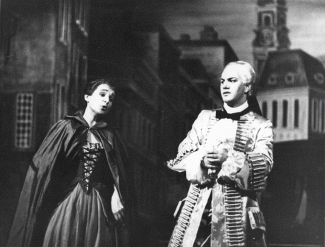The Rake's Progress

'We have rarely witnessed operatic direction of this calibre in Sweden.'Alf Thoor, Expressen
About the production
The music to the opera The Rake's Progress was written by Igor Stravinsky, with a libretto by W H Auden and Chester Kallman. Composed between 1948-51, it was first performed at the Venice Music Festival on 11 September 1951. Ten years later, on 22 April 1961, it was premiered at the Royal Theatre (now the Royal Swedish Opera) under the direction of Ingmar Bergman, and the production was a major success. Bergman had directed musical theatre before, with his 1954 production of The Merry Widow in Malmö, but this was the first time he had tried his hand at opera.
Bergman was faithful to Stravinsky's intentions of creating an 18th-century atmosphere. The scenographer Birger Bergling based his designs on the 18th-century English artist, William Hogarth's etchings which vividly portray the hustle and bustle of life at all levels of society in George II's England. Bergling's sets created a suitable framework and backdrop for Bergman's production. The outcome, according to many critics, was brilliant.
The stage was permanently open, without curtains, and was built out into the stalls in a way reminiscent of Shakespeare's Globe Theatre. Scenery changes took place openly, creating 'an intimate spectacle which forces the audience to feel involved at every moment'. (Erik Pettersson, Göteborgs-Tidningen). Curt Berg described the effect as if Bergman and Bergling had created a mixture of Shakespeare's Globe and the 18th-century theatre of the Palace of Drottningholm outside Stockholm.
Sources
- The Ingmar Bergman Archives.
- Birgitta Steene, Ingmar Bergman: A Reference Guide, (Amsterdam University Press, 2005).
All were impressed by the light and playful elements of the direction and stage sets. Bergman's pleasure at working at the Royal Opera became apparent in an interview with Bertil Widerberg in Sydsvenska Dagbladet on 6 April. He expresses his delight at the stage floor. 'Just look! Look at the slope, feel it, walk on it! In Malmö the floor was as flat as a pancake, here it slopes down to the footlights as it should do in an old court theatre. Isn't it wonderful?'
There was also a serious undercurrent to the production: 'from the first scene to the last, the production is carried along at a nervous pace that never falters.' (Erik Pettersson, Göteborgs-Tidningen). Bergman's experience from the stage and screen served him well:
Bergman moves around with ease. Sometimes one feels intimately close to the action, sometimes further away. One experiences something of the multi-dimensional quality of film, Bergman's fertile imagination breaks away from theatrical convention. He himself is the invisible participant in the drama. His presence is everywhere, in the words, in the movements, in groups and individuals.
Many critics noted the free and easy way in which the soloists and members of the chorus conducted themselves on the stage. Individual members of the chorus had developed a distinctive way of acting, breathing life and vigour into the crowd scenes. The soloists were widely praised: Kerstin Meyer as Baba, Margareta Hallin as Ann Truelove, Erik Saedén as Nick and especially Ragnar Ulfung as Tom.
Folke Hähnel, writing in Dagens Nyheter: 'The most amusing, most delicate and most balanced performance that the Stockholm Opera has displayed during the last several decades.'
In his review, Erik Pettersson spoke of the powerful effect of the performance and of his gratitude at having been present at such a theatrical experience. He was convinced that 'amongst the theatrical art forms, opera is the greatest and most rewarding in every respect. Something so brilliant, so skillful and so supremely polished in its execution has not been seen (in Sweden) since Aniara.'
Even outside Sweden, Bergman's debut in a new field did not go unnoticed. The New York Times featured an interview with Bergman (7 May 1961) and Opera News wrote glowingly about the production in an article published on 30 September.
Collaborators
- Margareta Hallin, Ann Trulove
- Kerstin Meyer, Baba
- Ragnar Ulfung, Tom Rakewell
- Erik Saedén, Nick Shadow
- Barbro Ericson, Mother Goose
- Arne Tyrén, Trulove
- Olle Sivall, Sellem
- Erik Sundquist, Guard
- F. Nilsson, Rehearsal
- A. Sunnegårdh, Chorus master
- Kerstin Hedeby, Costume design
- Wystan Hugh Auden, Libretto
- Chester Kallman, Libretto
- Igor Stravinsky, Music
- Ingmar Bergman, Director
- Birger Bergling, Designer
- Östen Sjöstrand, Translation